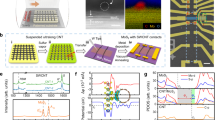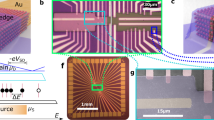Abstract
Existing models of electrical contacts are often inapplicable at the nanoscale because there are significant differences between nanostructures and bulk materials arising from unique geometries and electrostatics. In this Review, we discuss the physics and materials science of electrical contacts to carbon nanotubes, semiconductor nanowires and graphene, and outline the main research and development challenges in the field. We also include a case study of gold contacts to germanium nanowires to illustrate these concepts.
This is a preview of subscription content, access via your institution
Access options
Subscribe to this journal
Receive 12 print issues and online access
$259.00 per year
only $21.58 per issue
Buy this article
- Purchase on Springer Link
- Instant access to full article PDF
Prices may be subject to local taxes which are calculated during checkout







Similar content being viewed by others
Change history
28 November 2011
In the version of this Review originally published online, equation (2) appeared incorrectly. This has now been corrected in all versions of the Review
References
Peters, C. H., Guichard, A. R., Hryciw, A. C., Brongersma, M. L. & McGehee, M. D. Energy transfer in nanowire solar cells with photon-harvesting shells. J. Appl. Phys. 105, 124509 (2009).
Ishikawa, F. N. et al. Label-free, electrical detection of the SARS virus N-protein with nanowire biosensors utilizing antibody mimics as capture probes. ACS Nano 5, 1219–1224 (2009).
Dunn, B., Long, J. W. & Rolison, D. R. Rethinking multifunction in three dimensions for miniaturizing electrical energy storage. Electrochem. Soc. Interface 17, 49–53 (2008).
Chen, C. et al. Performance of monolayer graphene nanomechanical resonators with electrical readout. Nature Nanotech. 4, 861–867 (2009).
Misewich, J. A., Martel, R., Avouris, Ph., Tsang, J. C., Heinze, S. & Tersoff, J. Electrically induced optical emission from a carbon nanotube FET. Science 300, 783–786 (2003).
Zhang, Y., Ichihashi, T., Landree, E., Nihey, F. & Iijima, S. Heterostructures of single-walled carbon nanotubes and carbide nanorods. Science 285, 1719–1722 (1999).
Palacios, J. J., Pérez-Jiménez, A. J., Louis, E., SanFabían, E. & Vergés, J. A. First principles phase-coherent transport in metallic nanotubes with realistic contacts. Phys. Rev. Lett. 90, 106801 (2003).
Woodruff, S. M. et al. Nickel and nickel silicide Schottky barrier contacts to n-type silicon nanowires. J. Vac. Sci. Technol. B 26, 1592–1596 (2008).
Zhang, Z., Dikin, D. K., Ruoff, R. S. & Chandrasekhar, V. Conduction in carbon nanotubes through metastable resonant states. Europhys. Lett. 68, 713–719 (2004).
Tersoff, J. Schottky barrier heights and the continuum of gap states. Phys. Rev. Lett. 52, 465–468 (1984).
Léonard, F. & Tersoff, J. Role of Fermi-level pinning in nanotube Schottky diodes. Phys. Rev. Lett. 84, 4693–4696 (2000).
Léonard, F. & Talin, A. A. Size-dependent effects on electrical contacts to nanotubes and nanowires. Phys. Rev. Lett. 97, 026804 (2006).
Chen, Z., Appenzeller, J., Knoch, J., Lin, Y.-M. & Avouris, Ph. The role of metal-nanotube contact in the performance of carbon nanotube field-effect transistors. Nano Lett. 5, 1497–1502 (2005).
Kim, W. et al. Electrical contacts to carbon nanotubes down to 1 nm in diameter. Appl. Phys. Lett. 87, 173101 (2005). Refs 13 and 14 reported the experimental demonstrations that the band alignment at metal–nanotube contacts depended on the nanotube diameter.
Wang, C., Ryu, K., Badmaev, A., Zhang, J. & Zhou, C. Metal contact engineering and registration-free fabrication of complementary metal-oxide semiconductor integrated circuits using aligned carbon nanotubes. ACS Nano 5, 1147–1153 (2011).
Léonard, F., Talin, A. A., Swartzentruber, B. S. & Picraux, S. T. Diameter-dependent electronic transport properties of Au-catalyst/Ge-nanowire Schottky diodes. Phys. Rev. Lett. 102, 106805 (2009).
Giovannetti, G. et al. Doping graphene with metal contacts. Phys. Rev. Lett. 101, 026803 (2008).
Léonard, F. The Physics of Carbon Nanotube Devices (William Andrew, 2008).
Bachtold, A., Hadley, P., Nakanishi, T. & Dekker, C. Logic circuits with carbon nanotube transistors. Science 294, 1317–1320 (2001).
Mueller, T., Xia, F., Freitag, M., Tsang, J. & Avouris, Ph. Role of contacts in graphene transistors: a scanning photocurrent study. Phys. Rev. B 79, 245430 (2009).
Hun, J., Liu, Y., Ning, C. Z., Dutton, R. & Kang, S-M. Fringing field effects on electrical resistivity of semiconductor nanowire-metal contacts. Appl. Phys. Lett. 92, 083503 (2008).
Appenzeller, J., Radosavljevic, M., Knoch, J. & Avouris, Ph. Tunneling versus thermionic emission in one-dimensional semiconductors. Phys. Rev. Lett. 92, 048301 (2004).
Brillson, L. J. Contacts to Semiconductors: Fundamentals and Technology (Noyes, 1993).
Reeves, G. K. & Harrison, H. B. Obtaining the specific contact resistance from transmission line model measurements. IEEE Electron Dev. Lett. 3, 111–113 (1982).
Grosse, K. L., Bae, M.-H., Lian, F., Pop, E. & King, W. P. Nanoscale Joule heating, Peltier cooling and current crowding at graphene-metal contacts. Nature Nanotech. 6, 287–290 (2011).
Franklin, A. D. & Chen, Z. Length scaling of carbon nanotube transistors. Nature Nanotech. 5, 858–862 (2010). This paper demonstrates scaling of the contact length, and also scaling of the channel length down to 15 nm.
Nagashio, K., Nishimura, T., Kita, K. & Toriumi, A. Contact resistivity and current flow path at metal/graphene contacts. Appl. Phys. Lett. 97, 143514 (2010).
Xia, F., Pereibenos, V., Lin, Y.-M., Wu, Y. & Avouris, Ph. The origins and limits of metal-graphene junction resistance. Nature Nanotech. 6, 179–184 (2011).
Nemec, N., Tománek, D. & Cuniberti, G. Contact dependence of carrier injection in carbon nanotubes: an ab initio study. Phys. Rev. Lett. 96, 076802 (2006).
Solomon, P. Contact resistance to a one-dimensional quasi-ballistic nanotube/wire. IEEE Electron Dev. Lett. 32, 246–248 (2011).
Aguirre, C. M., Ternon, C., Paillet, M., Desjardins, P. & Martel, R. Carbon nanotubes as injection electrodes for organic thin film transistors. Nano Lett. 9, 1457–1461 (2009).
Cicoira, F., Aguirre, C. M. & Martel, R. Making contacts to n-type organic transistors using carbon nanotube arrays. ACS Nano 5, 283–290 (2011).
McCarthy, M. A. et al. Low-voltage, low-power, organic light-emitting transistors, for active matrix displays. Science 332, 570–573 (2011).
Dimoulas, A., Toriumi, A. & Mohney, S. E. Source and drain contacts for germanium and III-V FETs for digital logic. MRS Bull. 34, 522–529 (2009).
King, T-J. Taking silicon to the limit. Electrochem. Soc. Interface 14, 38–42 (2005).
Lavoie, C., d'Heurle, F. M., Detavernier, C. & Cabral, C. Towards implementation of a nickel silicide process for CMOS technologies. Microelec. Eng. 70, 144–157 (2003). This article details the morphology, composition and resistivity of Ni thin films reacting with Si, and explains why NiSi became the preferred metallization.
Ahn, C-G. et al. A two-step annealing process for Ni silicide formation in an ultra-thin body RF SOI MOSFET. Mater. Sci. Eng. B 147, 183–186 (2008).
Zhang, Z. et al. Sharp reduction in contact resistivities by effective Schottky barrier lowering with silicides as diffusion sources. IEEE Electron Dev. Lett. 31, 731–733 (2010).
Dellas, N. S. et al. Orientation dependence of nickel silicide formation in contacts to silicon nanowires. J. Appl. Phys. 105, 094309 (2009). This article describes the real-time observation (with a transmission electron microscope) of Ni reactions with Si nanowires as a function of anneal temperature.
Lin, Y-C., Chen, Y., Xu, D. & Huang, Y. Growth of nickel silicides in Si and Si/SiOx core/shell nanowires. Nano Lett. 10, 4721–4726 (2010).
Hong, S. H. et al. Electrical characteristics of nickel silicide–silicon heterojunction in suspended silicon nanowires, Solid State Electron 56, 130–134 (2011).
Motayed, A. et al. Correlation between the performance and microstructure of Ti/Al/Ti/Au Ohmic contacts to p-type silicon nanowires. Nanotechnology 22, 075206 (2011).
Dellas, N. S., Minassian, S., Redwing, J. M. & Mohney, S. E. Formation of nickel germanide contacts to Ge nanowires. Appl. Phys. Lett. 97, 263116 (2010).
Talin, A. A., Wang, G. T., Lai, E. & Anderson, R. J. Correlation of growth temperature, photoluminescence, and resistivity in GaN nanowires. Appl. Phys. Lett. 92, 093105 (2008).
Lee, T. I. et al. Electrical contact tunable direct printing route for a ZnO nanowire Schottky diode. Nano Lett. 10, 3517–3523 (2010).
Ho, J. C. et al. Controlled nanoscale doping of semiconductors via molecular monolayers. Nature Mater. 7, 62–67 (2008).
Martel, R. et al. Ambipolar electrical transport in semiconducting single-wall carbon nanotubes. Phys. Rev. Lett. 87, 256805 (2001).
Kane, A. A. et al. Graphitic electrical contacts to metallic single-walled carbon nanotubes using Pt electrodes. Nano Lett. 9, 3586–3591 (2009).
Jang, S. et al. Flexible, transparent single-walled carbon nanotube transistors with graphene electrodes. Nanotechnology 21, 425201 (2010).
Li, B. et al. All-carbon electronic devices fabricated by directly grown single-walled carbon nanotubes on reduced graphene oxide electrodes. Adv. Mater. 22, 3058–3061 (2010).
Aikawa, S. et al. Facile fabrication of all-SWNT field-effect transistors. Nano Res. 4, 580–588 (2011).
Perea, D. E., Wijayaa, E., Lensch-Falk, J. L., Hemesath, E. R. & Lauhon, L. J. Tomographic analysis of dilute impurities in semiconductor nanostructures. J. Solid State Chem. 181, 1642–1649 (2008).
Taraci, J. L. et al. Nanopillar growth mode by vapor-liquid-solid epitaxy. Appl. Phys. Lett. 84, 5302–5304 (2004).
Nishimura, T., Kita, K. & Toriumi, A. Evidence for strong Fermi level pinning due to gap states at metal/germanium interface. Appl. Phys. Lett. 91, 123123 (2007).
Sze, M. & Ng, K. K. Physics of Semiconductor Devices 3rd edn (Wiley 2007).
Rhoderick, E. H. & Williams, R. H. Metal–Semiconductor Contacts 2nd edn (Oxford Science, 1988).
Prasankumar, R. P., Choi, S., Trugman, S. A., Picraux, S. T. & Taylor, A. J. Ultrafast electron and hole dynamics in germanium nanowires. Nano Lett. 8, 1619–1624 (2008).
Spataru, C. D. & Léonard, F. Tunable bandgaps and excitons in doped carbon nanotubes made possible by acoustic plasmons. Phys. Rev. Lett. 104, 177402 (2010).
Simizu, M., Akimoto, H. & Ishibashi, K. Electronic transport of single-wall carbon nanotubes with superconducting contacts. Jpn. J. Appl. Phys. 50, 035102 (2011).
Cha, J. J. et al. Three-dimensional imaging of carbon nanotubes deformed by metal islands. Nano Lett. 7, 3770–3773 (2007).
Perea, D. E. et al. Direct measurement of dopant distribution in an individual vapor–liquid–solid nanowire. Nature Nanotech. 4, 315–319 (2009). The first report of spatially resolved measurements of dopant distribution in nanowires.
Chen, C., Yan, L., Kong, E. S-W. & Zhang, Y. Ultrasonic nanowelding of carbon nanotubes to metal electrodes. Nanotechnology 17, 2192–2197 (2006).
Robinson, J. A. et al. Contacting graphene. Appl. Phys. Lett. 98, 053103 (2011).
Czaban, J. A., Thompson, D. A. & LaPierre, R. R. GaAs core-shell nanowires for photovoltaic applications. Nano Lett. 9, 148–154 (2009).
Mariani, G. et al. Patterned radial GaAs nanowire solar cells. Nano Lett. 11, 2490–2494 (2011).
Landman, U., Barnett, R. N., Scherbakov, A. G. & Avouris, Ph. Metal-semiconductor nanocontacts: Silicon nanowires. Phys. Rev. Lett. 85, 1958–1961 (2000).
Acknowledgements
F.L. acknowledges financial support from the Laboratory Directed Research and Development Program at Sandia National Laboratories, which is by operated by Sandia Corporation, a Lockheed Martin Company, for the US Department of Energy (contract DE-AC04-94-AL85000).
Author information
Authors and Affiliations
Corresponding authors
Ethics declarations
Competing interests
The authors declare no competing financial interests.
Rights and permissions
About this article
Cite this article
Léonard, F., Talin, A. Electrical contacts to one- and two-dimensional nanomaterials. Nature Nanotech 6, 773–783 (2011). https://doi.org/10.1038/nnano.2011.196
Published:
Issue Date:
DOI: https://doi.org/10.1038/nnano.2011.196
This article is cited by
-
Graphene-enhanced silver composites for electrical contacts: a review
Journal of Materials Science (2024)
-
On photo-induced electrons in graphene-plasmonic nanoparticles
Applied Physics A (2023)
-
Nanomedicine’s transformative impact on anti-diabetic drug discovery: an appraisal
Journal of Nanoparticle Research (2023)
-
Silicon-processes-compatible contact engineering for two-dimensional materials integrated circuits
Nano Research (2023)
-
Molecular Junctions: Introduction and Physical Foundations, Nanoelectrical Conductivity and Electronic Structure and Charge Transfer in Organic Molecular Junctions
Brazilian Journal of Physics (2022)



